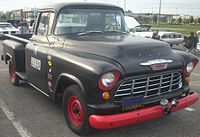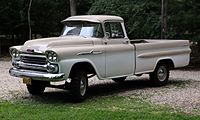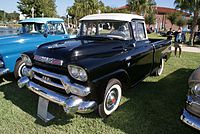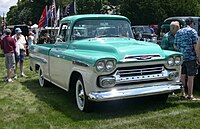Chevrolet Task Force
GM re-designed their truck line for the 2nd half of 1955, but sold both designs that year; the older design became known as the 1st series, and the newer design as the 2nd Series. Commercial trucks and various other heavy duty models were also available.[1] Chevrolet and GMC named their new series independently.
| Brand | 1955 2nd Series - 1959 Series | 1947 - 1955 1st Series |
|---|---|---|
| Chevrolet | "Task Force" | "Advance Design" |
| GMC | "Blue Chip" (short for "Blue Chip Money Makers") | "New Design" |
The cousins were differentiated by running gear and interiors; Chevrolet used Chevrolet engines, and GMC used GMC inline Sixes and Pontiac V8s (Oldsmobile V8s in the Heavy-Duty trucks).
For the first time in GM history, trucks were available with optional power steering, power brakes, and V8s. A column-shifted 3-speed manual transmission was standard, with an optional floor-shift-4 speed manual or Hydramatic automatic. The electrical system got an upgrade to 12 volts.
The new body featured the truck industry’s first wrap-around windshield,[2] and an optional wrap around rear window for Deluxe cab models.[3] Headlights became integrated into the fenders. The cab got taller, and in-cab steps replaced the running boards of previous models. A "step" between the cab and rear fender aided access to items inside the pickup bed. Redesigned bed fenders were carried through the next generation body that ended in 1966.
Differences
1955 Second Series: First year for new body style. Fenders have single headlights and a one-piece emblem is mounted below horizontal line on fender.[4] Beds are 6.5 ft (2.0 m) and 7.5 ft (2.3 m); 1955 was the only year for the mid-length 7-foot bed. The GMC inline-6 remained 6V for 1955 only.
A more luxurious version was produced with a "stylized" bed that eliminated stepside fenders, continuing the cab's body lines to the back of the truck; Chevrolet called theirs Cameo Carrier, GMC's version was called the "Suburban." The outer skins were Fiberglas, and attached to the top of a standard step-side cargo box (steel). A standard tailgate was supported by retractable cables, with latches mounted inside the bed. The multi-piece rear bumper featured a door that accesses a hidden spare tire carrier. Whitewall tires, a fancier interior, and chromed grille/front bumper/special rear bumper rounded out the package. The Suburban features matched the Cameo, minus any pickup bed side trim. Mechanically, Cameos were the same as the base pickup, and hauled the same amount of cargo.
1956: Wider hood emblem. Two-piece fender emblems are mounted above horizontal fender line. Last year for eggcrate grille.
1957: Only year for more open grille. Hood is flatter with two spears on top, similar to the 1957 Bel Air. Fender emblems are still above fender line, but are now oval-shaped, as opposed to previous versions in script.
1958: All light-duty trucks are now called "Apache", medium-duty trucks called "Viking", and heavy-duty trucks called "Spartan". First year for factory-equipped air conditioning. Significant redesign of front end, featuring a shorter/full-width grille, four Headlights instead of the previous two, and Parking lights are now in the grille instead of being in the front of the fender. The hood is similar to 1955/1956 models, but with a flat "valley" in the middle. A new "style-side" all-steel bed replaces the Cameo/Suburban versions; called "Fleetside" by Chevrolet and "Wideside" by GMC, available in 6.5 ft (2.0 m) and 8 ft (2.4 m) lengths. For 1958, GM was promoting their fiftieth year of production, and introduced Anniversary models for each brand (Cadillac, Buick, Oldsmobile, Pontiac, and Chevrolet[5]); the trucks also received similar attention to appearance, but staying essentially durable, with minimal adornment.
1959: Minimal changes from 1958, the most apparent was a larger and more ornate hood emblem and redesigned badging on the fenders. This was the last year that the NAPCO (Northwestern Auto Parts Company) "Powr-Pak" four-wheel drive conversion could be factory ordered.
1960: The Chevrolet and GMC C/K-Series replaced the line.
References
- ^ "1955 Chevrolet truck brochure" (PDF). GM heritage center. 1955. Retrieved April 16, 2020.
- ^ Bunn, Don. "Segment Five: 1955-1959 Early V8 Pickups", Pickuptruck.com. Archived 2019-01-12 at the Wayback Machine Retrieved on July 2, 2008.
- ^ "LMC Truck Catalog", Winter 2007/2008
- ^ "What Year is My Truck?", Classicparts.com. Retrieved on July 2, 2008.
- ^ Image of 50th Anniversary promotional photo Archived 2015-10-17 at the Wayback Machine










